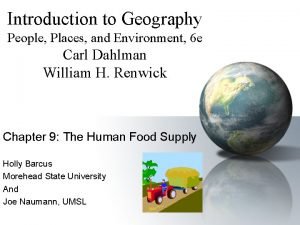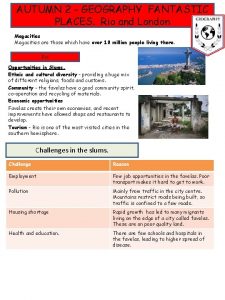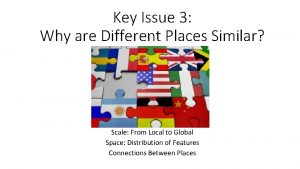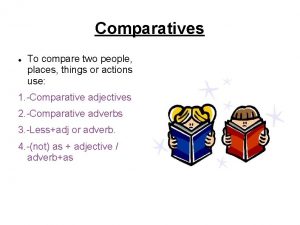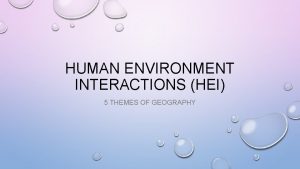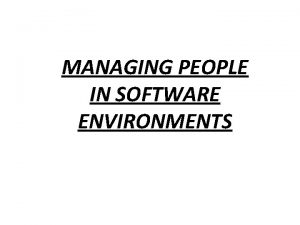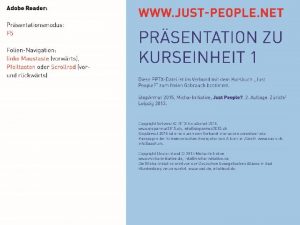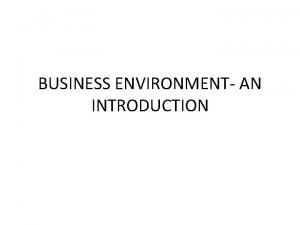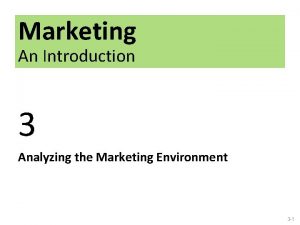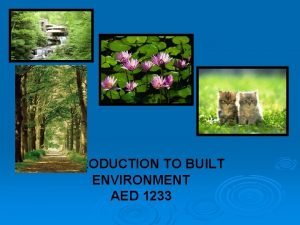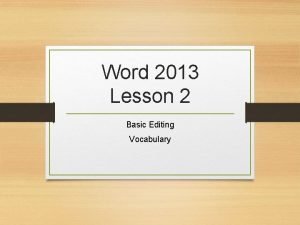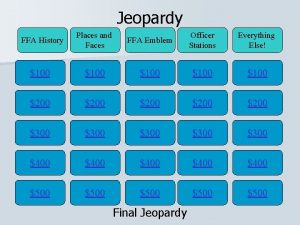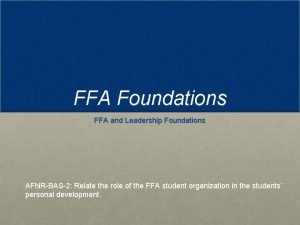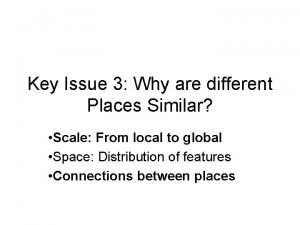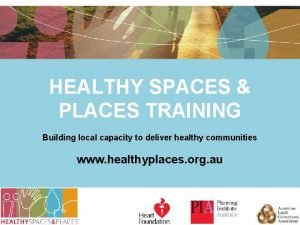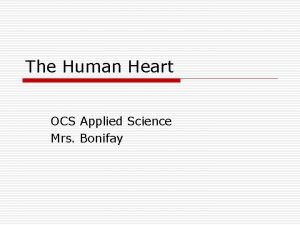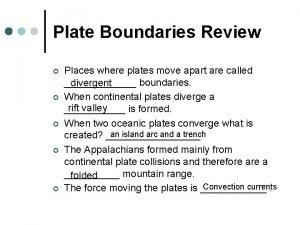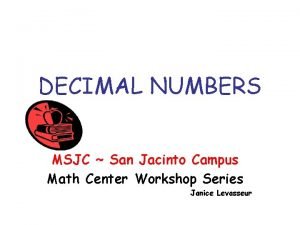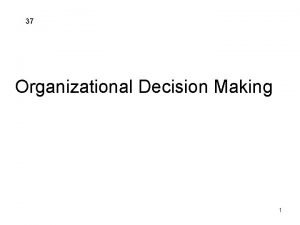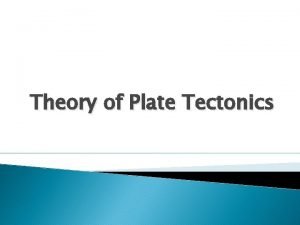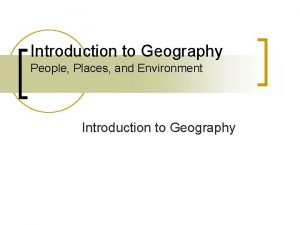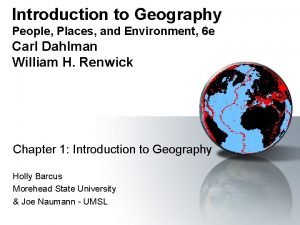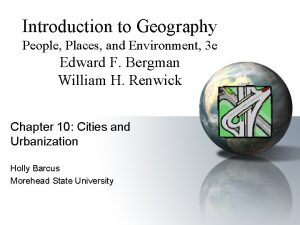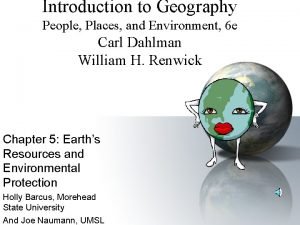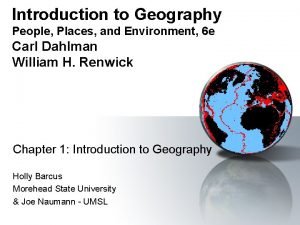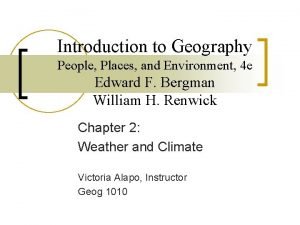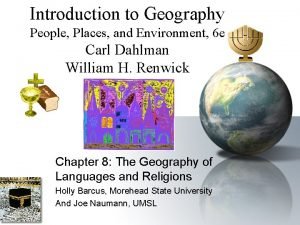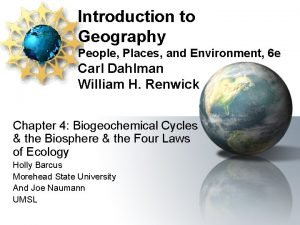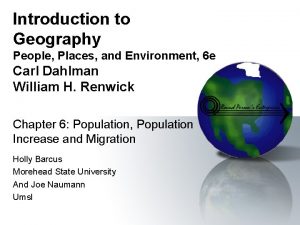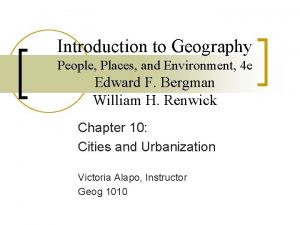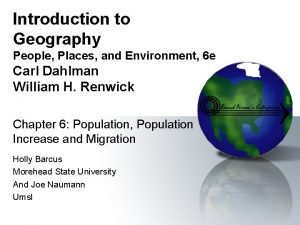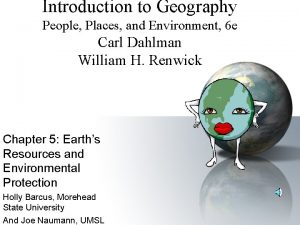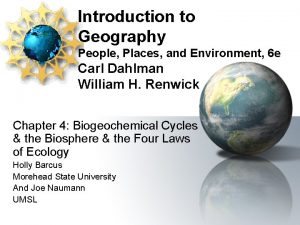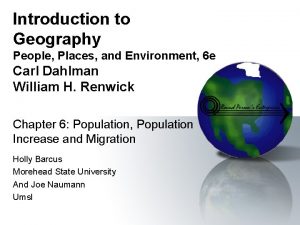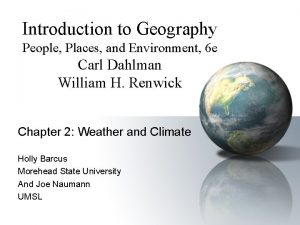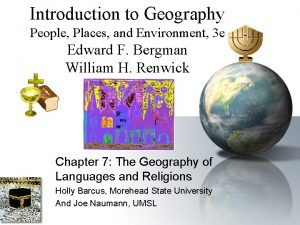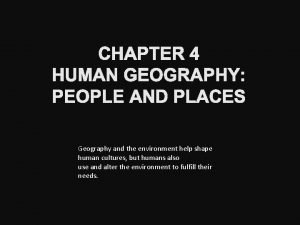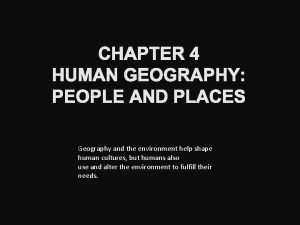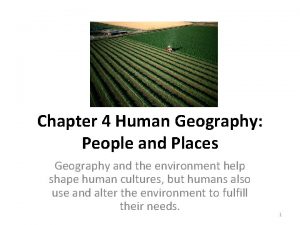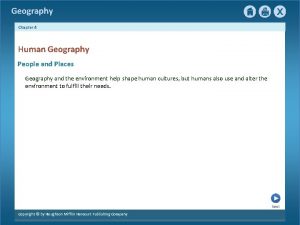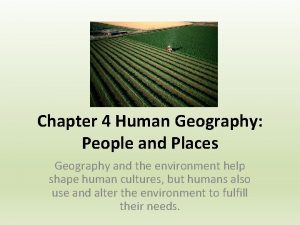Introduction to Geography People Places and Environment 6




































































- Slides: 68

Introduction to Geography People, Places, and Environment, 6 e Carl Dahlman William H. Renwick Chapter 9: The Human Food Supply Holly Barcus Morehead State University And Joe Naumann, UMSL

Food Supplies Over the Last 200 Years • Malthus’ prediction • New crops – Transplants and genetic engineering • New cropland – New lands opened by irrigation • Transportation and storage – Faster refrigerated modern methods – Improved storage protects against spoilage and pests • Green revolution – As applied to agriculture not environment • Technological advances 2

Domestication Sites • On the next map, notice that the early cradles of civilization tended to develop in or very near centers of domestication 3

Cradles of Civilization • Note the similarity 4

Land Use Regions

No More Virgin Lands • The discovery of the “New World” postponed the consequences of Malthus’ conclusions. All the land is under cultivation now. 6

Rice and Potato Production

Agriculture Today • Hunter-gatherers – few in remote places • Subsistence agriculture – largely developing countries – Food for self and family • Commercial agriculture – largely in developed countries – Food for sale • Polyculture – Raising a variety of crops • Mixed farming • Interculture • Monoculture – Specializing in one type 8

Subsistence and Commercial Agriculture • Subsistence Traits – Relies mostly on human labor – little animal or machine power – Low technology use – Smaller average farm size – Most food is consumed by farmer • Commercial Traits – Relies on capital investment in machinery, chemicals, improved seeds – Large average farm size – Products sold to agribusiness companies – Fewer family owned farms 9

Subsistence Commercial

Types of Agriculture • Defined by five variables – Natural environment (sets initial parameters) – Crops that are most productive in that environment – Degree of technology used – Market orientation – Raised for human or animal consumption • Human – Raw material for industry – Food • Animal – feed 11

Subsistence Agriculture • Click the picture to see the video 12

Mechanized, Commercial Agriculture • Click the collage to see the video 13

10 Categories of Agriculture • • • Irrigated Nomadic herding Low tech subsistence Intensive rice Asian mixed cereals/pulses • Mixed farming with livestock • Prairie cereals • Ranching • Mediterranean grains fruits and vegetables • Plantation agriculture 14

Types of Agriculture • Irrigated – Includes many farming styles from subsistence to intensive production • Nomadic herding – Pastoral nomads – Depend on animals – Animals sold or consumed – 12 -15 million nomads today – Government settlement 15

Types of Agriculture • Low-tech subsistence – Slash-and-burn – Swidden = “to singe” – Amazon, Central and West Africa – Supports low levels of population • Intensive rice farming – East, South and Southeast Asia – Work done by hand – Wet rice important source of food – Sawah – Double cropping 16

Swidden • Wise use of 17 land!

Labor-intensive Rice Harvesting • Click the picture to see the video 18

Subsistence Farming: processing rice in an African village. • Very simple technology is an improvement over the simplest form of separating husks. 19

Types of Agriculture • Asian mixed cereal and pulse farming – Interior India and northeast China – Wheat and barley – Pulses = pea or legume family • Mixed farming with livestock – Usually commercial – Crops fed to livestock – Dominant in most of world – Mixed farming in the “corn belt” 20

Mixed Farming: Dairy Farm • Milk production near cities – cheese, butter, & powdered milk farther away 21

Dairying • Where the climate is too wet and/or cold for good grain production • Requires heavy capital investment • Requires careful handling (govt. inspects) • 90% of cows milk is produced in developed countries – Costs high – Heavy, spoils easily – so high transport costs • Milk production near large urban areas • Easier to ship cheese, butter, & powdered milk farther distances 22

Corn: Human or Animal Food? • USA is agriculturally blessed 23

Hardy Grains

Maize (Corn) Outside the Western Hemisphere grown mostly for animal feed

Green Revolution • 1950 s focus on improving grain crops – Hybrids – Fertilizers & pesticides – Little research on tropical food crops • Has increased food production, but not in the most needy countries • Costs and risks discourage subsistence farmers 26

Types of Agriculture • Prairie cereals – Large scale commercial grain production – Wheat – Areas of concentration in North America • Ranching – Commercial grazing – Arid or semiarid land – Cattle – North and South America – Sheep – Australia • Winter wheat belt • Spring wheat belt • Palouse region – Eastern Washington State 27

Palouse Region Wheat Production Spring Wheat Belt Winter Wheat Belt

Research & Development: Australian Wheat Click the picture to see the video • This could expand wheat growing in many parts of the world 29

Grain Production

Types of Agriculture • Mediterranean – Mediterranean climates – Hot dry summers, cool rainy winters – Most crops for human consumption – Olives, grapes, fruits and vegetables • Plantation – Large commercial farm – Latin America, Asia, Africa – Coffee, sugarcane, bananas, rubber 31

Determining Productivity • Capital investment – Technology – Equipment – Fertilizers/pesticides – dangers of overuse – Irrigation • Natural environment – Technology and capital investment lessens the importance (expands the parameters) 32

33 Influences on Farmers

Commercial Farming • Requires capital investment, education, and considerable infrastructure to be efficient and profitable. Some good luck from “mother nature” 34 helps too.

A Measure of Capital Investment

Measure of Technology & Capital

Livestock • Grain consumption – Direct and indirect – Inefficiency of grain-fed animals • Per capita consumption of meat • Problems with animal production – Environmental • Dairy farming – Value added by manufacturing 37

Cattle Cows are considered sacred by Hindus – not eaten.

Livestock • Best suited to semiarid steppes – Overgrazing leads to desertification – Steppes can easily be overstressed • Controversy: direct or indirect consuming of grain & use of feed additives - hormones Animal Lbs. feed grain Meat produced Chicken 4 pounds 1 pound meat Pig 7 pounds 1 pound pork Cow 15 pounds 1 pound beef 15 lbs. of corn feeds more people than 1 lb. Beef. 39


Future Food Supplies • New crop potential – Preserving genetic diversity • Importance of wild plants – Cultural acceptance – High protein maize in Mexico, etc. • Scientific revolution – Gene splicing – Genetically modified (GM) – great controversy – Cloning • Resistance to biotechnology – Religious / cultural / environmental • Global warming – climate change will affect food production 41

Food For The Future: Challenges • Improved efficiency in irrigation – Only 37% of water reaches plants currently – Improve drip irrigation • Reduced spread of parasitic diseases • Reduced soil salination • Introduce new plants – 50 types of potato – U. S. uses 2 -3 – 20 species provide most food today • 75, 000 plants have edible parts – Culture factor often resists “unusual” foods 42

World Food Production

Distribution of Supplies and Production • Enough food for all but poor distribution – Hunger/famine • Sahel – Political strife • Sudan today & Nigeria in 1966 -68 • Countries import and export food • Increase in production – Green revolution least effective in tropical areas • Improvement in distribution – Costly & difficult – hampered by political factors 44

Best areas for productive agriculture CHECK IT OUT! 45

What about 500 mil. Malnourished people (1991)? • Largely in Developing Countries • What could, not will, these countries do to end or reduce undernourishment? – Stop subsidizing urban areas Stop discriminating against farmers – End civil wars – Reform landholding systems – Encourage a switch from “cash crops” to crops for domestic consumption 46

World Undernourishment ? Hunger in America?

New Uses for Farm Products Click on the mad scientist to see the video • Many food crops or parts of plants have other potential uses – biomass for methane gas, plastics from peanuts, 48 etc.


Problems Increasing Food Production • Diminishing returns of fertilizers • Financial incentives – Pricing controls – Taxes • Land ownership – Concentration of ownership • Whither the family farm? – Collective farming/ Communism • Commercial cash crops in developing countries – Leading to economic self sufficiency? – Illegal drugs 50

Desertification is a major problem, particularly in Africa • Physiologic pressure plus cycles of dry years results in over-stressing the soil and vegetation – thereby increasing the desert • Practices leading to desertification – Overgrazing marginal lands – Planting in the year that a field should lie fallow – Trying to expand agriculture into areas where the rainfall is too unreliable 51

Drug Traffic

Policies of Wealthy Countries • High tariffs to protect markets • Farm subsidies – Encourage surpluses in rich areas – Decrease production in poor areas – Impact on world market 53

Subsidies: Reasons & Results • Reasons – Protects farmers – National security – Tradition – Political (electoral college) • Results – Low price – Restricts competition – Effect on trade and production 54


Fish Harvest • Traditional fishing – Physical and financial risks – Small fraction of global catch • Modern fishing – Fisheries – Overfishing and depletion – Increasing regulation • Aquaculture – Herding and domesticating aquatic species – Fertilizer production 56

World Fishing Grounds

Aquaculture: On Land & Sea Artificial ponds for fish farming Boat being built for fish farming • Great potential for using land not suited to farming 58 & preserving fish species

Long-term policy must be “sustained yield” 59

Sustained Yield is the Goal: • Plans must be developed based on the long -range benefits. • Developers must resist the temptation to seek larger, short-term gains at the expense of the health of ecosystem. • In the “market economy” people usually concentrate more on the latter rather than the former point of view. • The following slides show good agricultural practices that must be encouraged! 60

Education is Essential • Women = 50% of agricultural workers • Educating women in Kenya 61

Contour Plowing When Land Isn’t Level 62

Reasonable, Responsible Use of Aquifer Water for Irrigation 63

Crop Rotation 64

Careful Use of Hilly Land • Careful grazing • Orchards & vineyards • Terraced with great care 65

Protect the Soil • Loss of good soil must be kept to a minimum 66

Wake Up And Smell The Roses! 67

Particularly in USA, but not only there – stop urban sprawl on good farmland • Building subdivisions on good farmland makes absolutely not sense in the long-run. • It is difficult to discourage this in a market economy – it requires most people to develop social consciousness and to actually practice what they say they believe. • Some of the richest farmland in the world is in Florissant – how many farms are there today? End of Chapter 8 68
 Human geography places and regions in global context
Human geography places and regions in global context Unit 1 people
Unit 1 people People and places
People and places People and places
People and places People and places
People and places Fantastic places geography
Fantastic places geography Key issue 3 why are different places similar
Key issue 3 why are different places similar Compare two people
Compare two people Proper nouns of places
Proper nouns of places People places leisure
People places leisure Chapter 7 congress at work
Chapter 7 congress at work Safe people safe places
Safe people safe places The names of people, places, things, or ideas
The names of people, places, things, or ideas Words that name people, places, things, or ideas
Words that name people, places, things, or ideas They provide information to media users
They provide information to media users Environment of business finance
Environment of business finance Olmec geography/environment
Olmec geography/environment Human environment interaction definition geography
Human environment interaction definition geography What is the meaning of where is the love by black eyed peas
What is the meaning of where is the love by black eyed peas Managing people in software environment
Managing people in software environment Ap human geography frqs
Ap human geography frqs 5 themes of geography ap human geography
5 themes of geography ap human geography Proruption ap human geography
Proruption ap human geography Transformed people transform people
Transformed people transform people People just people
People just people Introduction on environment
Introduction on environment Internal environment factors
Internal environment factors Companies who passively accept the marketing environment
Companies who passively accept the marketing environment Definition aed
Definition aed Resourceful citer
Resourceful citer 2 significant figures upper and lower bounds
2 significant figures upper and lower bounds Word basic
Word basic Places and faces of the ffa
Places and faces of the ffa Ffa mission statement
Ffa mission statement Why are different places similar
Why are different places similar Cloud computing places the processing and
Cloud computing places the processing and Healthy spaces and places
Healthy spaces and places Healthy places and spaces
Healthy places and spaces Smiling faces beautiful places
Smiling faces beautiful places Why do individual languages vary among places
Why do individual languages vary among places What is the name of the island tamal tells andy about
What is the name of the island tamal tells andy about 3 decimal places
3 decimal places Famous places in lithuania
Famous places in lithuania Places you can feel your pulse
Places you can feel your pulse Great faces
Great faces Rounding decimal places
Rounding decimal places What is a round number
What is a round number Three decimal places
Three decimal places 10 steps to protect heritage places
10 steps to protect heritage places Point lagrange
Point lagrange Places where plates move apart
Places where plates move apart Materi bahasa inggris kelas 6 public places
Materi bahasa inggris kelas 6 public places Locating places
Locating places 4 decimal places
4 decimal places Preposition of places
Preposition of places Naming words for places
Naming words for places Contoh space order
Contoh space order Ones tens hundreds thousands
Ones tens hundreds thousands Decimal tenths place
Decimal tenths place Moving decimals to the right
Moving decimals to the right Put these nouns into the right category
Put these nouns into the right category The incremental decision process model places emphasis on:
The incremental decision process model places emphasis on: Match the places with pictures
Match the places with pictures Do you know these places
Do you know these places Trigonometry jeopardy
Trigonometry jeopardy Tectonic plates interact at places called plate
Tectonic plates interact at places called plate 1 gagnant 3 places
1 gagnant 3 places Jubail tourist places
Jubail tourist places Kirsten places her surveyor's telescope
Kirsten places her surveyor's telescope



